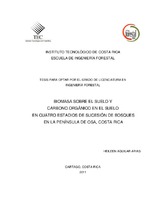Mostrar el registro sencillo del ítem
"Biomasa sobre el suelo y carbono orgánico en el suelo en cuatro estadios de sucesión de bosques en la Península de Osa, Costa Rica"
| dc.contributor.author | Aguilar-Arias, Heileen | |
| dc.date.accessioned | 2015-04-14T17:42:38Z | |
| dc.date.available | 2015-04-14T17:42:38Z | |
| dc.date.issued | 2011 | |
| dc.identifier.uri | https://hdl.handle.net/2238/5746 | |
| dc.description | Proyecto de Graduación (Licenciatura en Ingeniería Forestal). Instituto Tecnológico de Costa Rica. Escuela de Ingeniería Forestal, 2011. | es |
| dc.description.abstract | As part of the project "Baseline studies of biodiversity, environmental services and values to the conservation of secondary and mature forests in the Osa Biological Corridor" was established 20 permanent monitoring plots (PPM Spanish abbreviation) of 5000 m2 (50x100m) at Osa Peninsula, Puntarenas, Costa Rica. These plots were established in 2009, 2010 and 2011, and distributed in in four sectors areas Rio Piro, Matapalo, Los Mogos and Bahia Chal. For this study quantified the amount of dry biomass accumulated in litter, dead wood biomass and the amount of soil organic carbon (SOC) in four forest successional stages: 5 to 15 years, 15 to 30 years over 30 years old and primary forest. A simple random design with sub-sampling, four treatments (successional stage), five repetitions (PPM) and four samples per PPM was established. The accumulated biomass in litter was higher in primary forests with 9.75 t ha-1, followed by forests over 30 years with 7.93 t ha-1, 15-20 years with 5.97 t ha-1 and finally forests 5-15 years with 5.60 t ha-1. The values of biomass in dead wood were of 7.80 t ha-1 in primary forests, 5.84 t ha-1 in 15-30-year forests; 3.26 t ha-1 in forests older than 30 years and 3.42 t ha-1 in 5-15-year forest. The soil organic carbon was higher in forests over 30 years (109.24 tC ha-1), followed by primary forest (92.29 tC ha-1), 15-30-year forest (88.01 tC ha-1); lastly, 5-15-year forest (78.48 tC ha-1). There were statistical differences (α = 0.05) in biomass of accumulated litter on forest forests 5-15 years. The trends show an increase in the amount of biomass accumulated in litter with increasing successional stage. Dead wood biomass showed no statistical differences in age of the forest (α = 0.05). The soil organic carbon (SOC) showed statistical differences (α = 0.05) in forests of 5-15 years for forests older than 30 years. This work shows the dynamics of accumulation of above-ground biomass and organic carbon in soil as a variation with respect to forest age, where general trends were observed increased with successional stage, which could become a stage of recovery of degraded areas and their use as carbon sinks, as a viable option for owners of forests | es |
| dc.description.sponsorship | Instituto Tecnológico de Costa Rica. Escuela de Ingeniería Forestal. | es |
| dc.language.iso | es | es |
| dc.publisher | Instituto Tecnológico de Costa Rica | es |
| dc.rights | acceso abierto | es |
| dc.subject | Densidad | es |
| dc.subject | Madera | es |
| dc.subject | Trópicos | es |
| dc.subject | Ecosistemas | es |
| dc.subject | Efecto invernadero | es |
| dc.subject | Radiación | es |
| dc.title | "Biomasa sobre el suelo y carbono orgánico en el suelo en cuatro estadios de sucesión de bosques en la Península de Osa, Costa Rica" | es |
| dc.type | proyecto fin de carrera | es |


